


xxxxxStrife between the northern and southern states of the United States had been a long time in the coming. The north, much more advanced industrially, was opposed to slavery, whilst the South depended upon it. And trade tariffs set by the North to protect its fledgling industries meant higher priced goods for the southern states, already concerned at the growing influence of the northern states in the governing of the Union. When Abraham Lincoln was elected president in 1861, promising that slavery would not be allowed in the new states emerging in the West, the break came. South Carolina left the Union in December 1860, and together with six other states -
THE AMERICAN CIVIL WAR 1861 -
Acknowledgements
Map (United States): licensed under Creative Commons. Author: United States_1861-
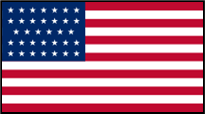
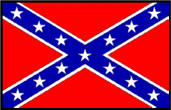 xxxxxFor many years there had been growing antagonism between the southern and northern states in the United States. The large cotton plantations in the south were dependent upon black slaves from Africa, whilst in the northern states -
xxxxxFor many years there had been growing antagonism between the southern and northern states in the United States. The large cotton plantations in the south were dependent upon black slaves from Africa, whilst in the northern states -
xxxxxBut the cause of the division was not confined to the issue of slavery. The economies of the two regions were fundamentally different. The South was almost exclusively agricultural, whereas the North was industrialised and becoming more so with every year that passed. And to protect this growing number of fledgling industries, trade tariffs were introduced, thereby preventing the import of cheaper manufactured goods into the poorer southern states. And in addition, friction was growing over the increasing interference of the federal government in the affairs of individual states, a bone of contention which had not gone away since the birth of the Union. Furthermore, it was felt in the south that central government was being slowly but surely manipulated by the northern industrialists and business entrepreneurs, becoming increasingly more powerful and influential by their growing wealth.
xxxxxThe almost inevitable conflict between these two very different ways of life was sparked off in 1860 with the election of president Abraham Lincoln. Known as a “black Republican”, he was openly opposed to slavery and made it clear that whilst he would not abolish slavery in states where it already existed, he would certainly ban the practice in the new states emerging in the west. The first state that refused to accept such a proposition was South Carolina. In December 1860 it gave notice that it had left the Union, and by March the following year, when Lincoln was officially made president, six other slave states -
Va-
Including:
The Trent Affair, Harriet
Elizabeth Beecher Stowe,
and Stephen Foster.

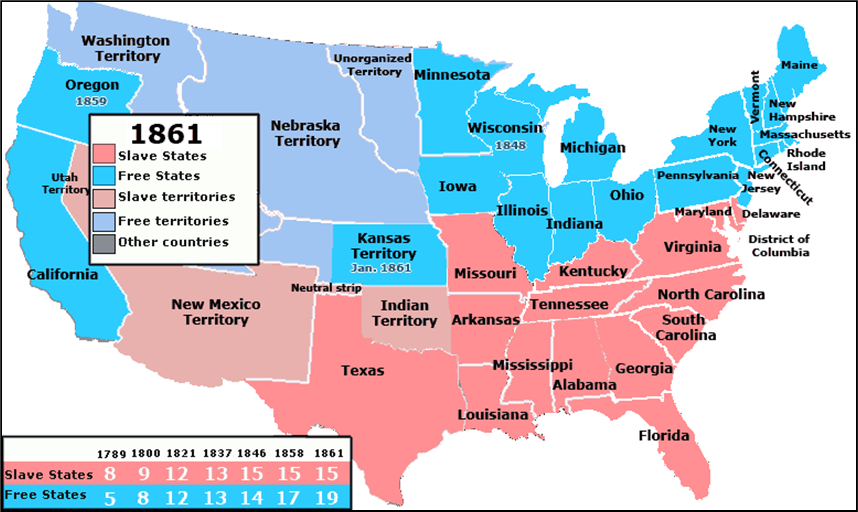
xxxxxLincoln was truly alarmed at this development. He had appealed for harmony in his inaugural speech, and had made it clear that he was for conciliation on all matters save one, his determination to preserve the Union. He would defend the integrity of the nation, but he would not be the first to use force. Thus his message to the seven southern states was very plain: “You can have no conflict without being yourselves the aggressors”. In the meantime, frantic efforts were made to find a solution, but it was clear that neither side was prepared to compromise. Indeed, by early 1861 the Confederacy had seized all but two of the U.S forts within their territory. Only Fort Pickens and Fort Sumter remained in the hands of U.S. troops.
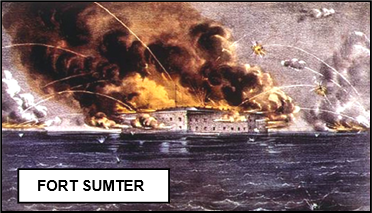 xxxxxThen on the 12th April 1861 the Confederacy chose to become the aggressors and set the conflict in motion. Claiming that it was a threat to its security, it ordered the evacuation of Fort Sumter, a fortress in the throes of being built at the entrance to Charleston harbour. When the Federal garrison refused, Confederate artillery bombarded the fort (illustrated) and it was taken two days later. In fact, the fort, built for coastal defence, was of little immediate value to either side, but for the North it was an act of war and a call to arms. Lincoln raised an army of 75,000 volunteers to restore the Union by force and, in response, four other southern states -
xxxxxThen on the 12th April 1861 the Confederacy chose to become the aggressors and set the conflict in motion. Claiming that it was a threat to its security, it ordered the evacuation of Fort Sumter, a fortress in the throes of being built at the entrance to Charleston harbour. When the Federal garrison refused, Confederate artillery bombarded the fort (illustrated) and it was taken two days later. In fact, the fort, built for coastal defence, was of little immediate value to either side, but for the North it was an act of war and a call to arms. Lincoln raised an army of 75,000 volunteers to restore the Union by force and, in response, four other southern states -
xxxxxOn paper, the South was very much the weaker side. It was made up of fifteen states, as opposed to nineteen, and its population was less than half that of the North. Furthermore, in some southern states, such as Georgia and Mississippi, a large number of people supported the Union. And in the matter of industrial power the South was very much at a disadvantage, having to import most of its war material from overseas. This in itself was difficult, because the American navy was able to blockade southern ports, preventing the import of equipment and the export of the South’s staple crops, cotton, sugar and tobacco. Nonetheless, due in large part to the superiority of the Confederate generals, the war was to be a bloody, bitter conflict which, in the course of four years, was to tear the country apart, produce 900,000 casualties, and leave a long-
xxxxxIn the opening phase of the war the Confederates stood on the defensive, despite an army numbering well over 250,000. They expected that France and Britain would come to their aid, but, in fact, all the European nations remained neutral. The Union or Federal forces made the first move. In July 1861 30,000 troops invaded Virginia and marched towards Richmond, the Confederate capital. Enxroute, however, they were met by a southern force under Generals Thomas Jackson and Pierre Beauregard. After a running battle, the Union force was roundly defeated near a small stream known as Bull Run and driven back towards Washington. As a result of this surprising setback, the North recruited more men and a military training programme was put into operation.
xxxxxAs we shall see, the Confederates were to win a second battle at this site in August 1862 (Vb), but by that time the Union army had close on half a million men. In the west this superiority was to prove decisive.
x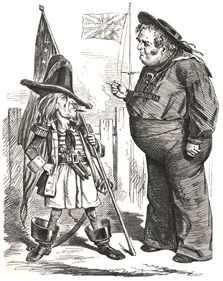 xxxxReference must be made here to the “Trent Affair”, a diplomatic incident in the first year of the Civil War which almost precipitated a conflict between Britain and the United States. This occurred in the November when crew members of a Union warship named San Jacinto -
xxxxReference must be made here to the “Trent Affair”, a diplomatic incident in the first year of the Civil War which almost precipitated a conflict between Britain and the United States. This occurred in the November when crew members of a Union warship named San Jacinto -
xxxxxIncidentally, it was during the First Battle of Bull Run in 1861 that the Confederate general Thomas Jackson (1824-
xxxxx…… Inxthe 1850s the state of Kansas had provided a prelude to the American Civil War. In 1830 Kansas had been designated an Indian Territory, but in 1854 the Kansas-
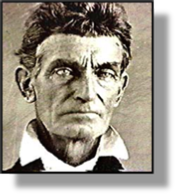 xxxxx…… Andxit was during that “war” that a Kansas farmer, John Brown (1800-
xxxxx…… Andxit was during that “war” that a Kansas farmer, John Brown (1800-
xxxxx…… As noted earlier, the term “Dixie”, the popular name for the American South, may have come from a song composed by the American Daniel Decatur Emmett in 1859, two years before the outbreak of the civil war. It was called Dixie and proved so popular as a marching song that during the conflict it came to be regarded as the unofficial national anthem of the Confederacy. ……
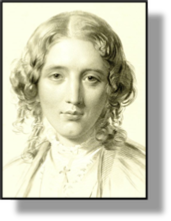
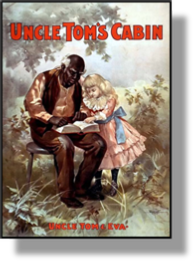 xxxxxA powerful contribution to the anti-
xxxxxA powerful contribution to the anti-
xxxxxOutside of the South, the story proved immensely popular. It was translated into over twenty languages, adapted for the stage, and in the United States alone sold half a million copies in the first five years. Abraham Lincoln recognised the story’s importance in the struggle against slavery, and it is often included as one of the causes of the civil war. Four years later she published a further attack on slavery in her Dred: A Tale of a Great Dismal Swamp. Among her other works were some excellent descriptions of rural life in New England, and the romantic novel The Minister’s Wooing of 1859. She visited Europe in 1853 and was well received in England, but later, in 1869, she lost much favour in that country when she wrote an article roundly criticising the personal life of Lord Byron.
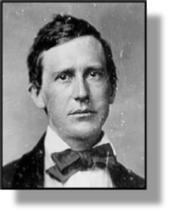
xxxxxVery much associated with the South during the years leading up to the civil war were the popular songs of the American composer Stephen Foster (1826-
xxxxxHe made only one visit to the South, but captured the rhythmic tunes of the Deep South by attending black church meetings and listening to the singing of black labourers in the work places of Pittsburgh. His songs were popular, but he was a poor business man and made little money from them. In later life he took to drinking heavily and fell into debt. He lived alone in New York City from 1860, and it was here that he died of alcoholism in 1864. The Stephen Foster Memorial, a large park in White Springs, Florida, contains a museum about his life and work, and the Carillon Tower, an attractive building from where a set of 97 bells plays a medley of his songs each day. There is also a museum to his memory on the campus of the University of Pittsburgh.
xxxxxIncidentally, it is said that when he died at the Bellevue Hospital in New York he had just 38 cents in his pocket and a piece of paper on which was written “dear friends and gentle hearts”.


